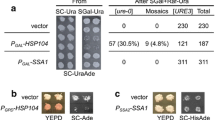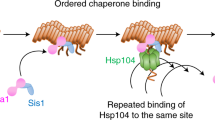Abstract
Amyloid contents were quantitatively assayed in crude yeast lysates treated with thioflavin T that specifically stained amyloid fibrils. We demonstrated that guanidine hydrochloride (GuHCl) treatment and overexpression of Hsp104p chaperone resulted in the elimination of the [PSI +] factor and that the stable decline in amyloid contents followed from the reduced fluorescence intensity (IF) of thioflavin T. Overexpression of the SUP35 gene coding the protein prionizable to [PSI +] results in the generation of [PSI +] clones with increased thioflavin T IF. Transmission of [PSI +] factor by cytoduction in crossings of recipients with low IF was also accompanied by stable IF enhancement in cytoductants, indicating enriched amyloid contents. Thus, in model experiments, modifying the quantity of [PSI +] factor, a yeast prion amyloid, the change in thioflavin T IF corresponds to the expected shift in amyloid contents, the IF shift behaving as a cytoplasm hereditary determinant. It is concluded that thioflavin T IF allows for the quantitative estimation of amyloid contents in cells. The stable mitotic IF shift induced by agents affecting the prion composition permits the quantitative evaluation of prion contribution into amyloid pool. It is possible to assume that the monitoring of thiophlavin T IF shifts under the exposure of agents affecting prion pattern may be helpful to disclose previously unknown prions in yeast strains.
Similar content being viewed by others
References
Bradley, M.E. and Liebman, S.W., Destabilizing Interactions among [PSI +] and [PIN +] Yeast Prion Variants, Genetics, 2003, vol. 165, pp. 1675–1685.
Chernoff, Y.O., Cellular Control of Prion Formation and Propagation in Yeast, in Prions and Prion Diseases: Current Perspectives, Wymondham: Horizon Bioscience, 2004, pp. 257–303.
Chernoff, Y.O., Derkatch, J.L., and Inge-Vechtomov, S.G., Multicopy SUP35 Gene Induces de novo Appearance of psilike Factors in the Yeast Saccharomyces cerevisiae, Curr. Genet., 1993, vol. 24, pp. 268–270.
Chernoff, Y.O., Lindquist, S.L., Ono, B., Inge-Vechtomov, S.G., and Liebman, S.W., Role of the Chaperone Protein hsp104 in Propagation of the Yeast Prion-like Factor [PSI +], Science, 1995, vol. 268, pp. 880–884.
Chernoff, Y.O., Newnam, G.P., Kumar, J., Allen, K., and Zink, A.D., Evidence of a Protein Mutator in Yeast: Role of the Hsp70-related Chaperone Ssb in Formation, Stability and Toxicity of the [PSI] Prion, Mol. Cell. Biol., 1999, vol. 19, pp. 8103–8112
Chernoff, Y.O., Uptain, S.M., and Lindquist, S.L., Analysis of Prion Factors in Yeast, Meth. Enzymol., 2002, vol. 351, pp. 499–537.
Derkatch, J.L., Bradley, M.E., Zhou, P., Chernoff, Y.O., and Liebman, S.W., Genetic and Environmental Factors Affecting the de novo Appearance of the [PSI +] Prion in Saccharomyces cerevisiae, Genetics, 1997, vol. 147, pp. 507–519.
Ferreira, P.C., Ness, F., Edwards, S.R., Cox, B.S., and Tuite, M.F., The Elimination of Yeast [PSI +] Prion by Guanidine Hydrochloride Is the Result of Hsp104 Inactivation, Mol. Microbiol., 2001, vol. 40, pp. 1357–1369.
Heppner, F.L. and Aguzzi, A., Prions, Nature Publishing Group Encyclopedia of Life Sciences, Nature Publishing Group, 2002, www.els.net.
Kimura, Y., Koitabashi, S., Kakizuka, A., and Fujita, T., Analysis of Yeast Prion Aggregates with Amyloid-staining Compound in vivo, Cell. Struct. Funct., 2003, vol. 28, pp. 187–193.
King, C.-Y. and Diaz-Avalos, R., Protein Only Transmission of Three Yeast Prion Strains, Nature, 2004, vol. 428, pp. 323–328.
Kocheneva-Pervukhova, N.V., Chechenova, M.B., Valouev, I.A., Kushnirov, V.V., Smirnov, V.N., and Ter-Avanesyan, M.D., [PSI +] Prion Generation in Yeast: Characterization of the “Strain” Difference, Yeast, 2001, vol. 18, pp. 489–497.
Kryndushkin, D.S., Alexandrov, I.M., Ter-Avanesyan, M.D., and Kushnirov, V.V., Yeast [PSI +] Protein Aggregates Are Formed by Small Sup35 Polymers Fragmented by Hsp104, J. Biol. Chem., 2003, vol. 278, pp. 49636–49643.
Michelitsch, M.D. and Weissman, J.C., A Census of Glutamine/Asparagine-rich Regions: Implications for Their Conserved Function and the Prediction of Novel Prions, Proc. Natl. Acad. Sci. U.S.A., 2000, vol. 97, pp. 11 910ó11 915.
Nevzglyadova, O.V., Artyomov, A.V., Gaivoronskii, A.A., and Soidla, T.R., Concealed Nuclei in Saccharomyces Strains (MiniReview), FEMS Yeast Res., 2002, vol. 2, pp. 471–479.
Nevzglyadova, O.V., Artyomov, A.V., Mikhailova, E.V., and Soidla, T.R., The Impact of Manipulations with Cytoplasmically Inherited Factors on Nuclear Transmission and Degradation in Yeast Heterokaryons, Curr. Genet., 2004, vol. 45, pp. 273–282
Nevzglyadova, O.V., Artyomov, A.V., Mikhailova, E.V., and Soidla, T.R., Bud Selection and Apoptosis-like Degradation of Nuclei in Yeast Heterokaryons: a KAR1 Effect, Mol. Gen. Genomics, 2005, vol. 274, pp. 419–427.
Ross, E.D., Baxa, U., and Wickner, R.B., Scrambled Prion Domains Form Prions and Amyloid, Mol. Cell. Biol., 2004, vol. 24, pp. 7206–7213.
Ross, E.D., Minton, A., and Wickner, R.B., Prion Domains: Sequences, Structures and Interactions, Nature Cell. Biol., 2005, vol. 7, pp. 1039–1044.
Sachs L., Statistische Auswertungsmethoden, Berlin: Springer, 1972.
Schwimmer, C. and Masison, D.C., Antagonistic Interaction between Yeast [PSI +] and [URE3] Prions and Curing of [URE3] by Hsp70 Protein Chaperon Ssa1p but Not by Ssa2p, Mol. Cell Biol., 2002, vol. 22, pp. 3590–3598.
Severin, S.E and Solov’eva, G.A., Practicum po biokhimii (Handbook on Biochemistry), Moscow: Izd. MGU, 1989.
Sherman, F., Fink, G.R., and Hicks, J.B., Laboratory Course Manual for Methods in Yeast Genetics, Cold Spring Harbor: Cold Spring Harbor Laboratory Press, 1986.
True, H.L. and Lindquist, S.L., A Yeast Prion Provides a Mechanism for Genetic Variation and Phenotypic Diversity, Nature, 2000, vol. 407, pp. 477–483.
True, H.L., Berlin, I., and Lindquist, S.L., Epigenetic Regulation of Translation Reveals Hidden Genetic Variation to Produce Complex Traits, Nature, 2004, vol. 431, pp. 184–187.
Voropai, E.S., Samtsov, M.P., Kaplevskii, K.N., Maskevich, A.A., Stepuro, V.I., Povarova, O.I., Kuznetsova, I.M., Turoverov, K.K., Fink, A.L., and Uverskii, V.N., Spectral Properties of Thioflavin T and Its Complexes with Amyloid Fibrils, J. Appl. Spectroscopy, 2003, vol. 70, pp. 868–874.
Zakharov, I.A. and Yarovoy, B., Cytoduction As a New Tool in Studying the Cytoplasmic Heredity in Yeast, Mol. Cell Biochem., 1977, vol. 14, pp. 15–18.
Author information
Authors and Affiliations
Corresponding author
Additional information
Original Russian Text © O.V. Nevzglyadova, I.M. Kuznetsova, A.V. Artemov, E.V. Mikhailova, K.K. Turoverov, T.R. Soidla, 2008, published in Tsitologiya, Vol. 50, No. 1, 2008.
Rights and permissions
About this article
Cite this article
Nevzglyadova, O.V., Kuznetsova, I.M., Artemov, A.V. et al. Comparative assay of amyloid and prion contents in yeast cells. Cell Tiss. Biol. 2, 71–80 (2008). https://doi.org/10.1134/S1990519X08010112
Received:
Published:
Issue Date:
DOI: https://doi.org/10.1134/S1990519X08010112




